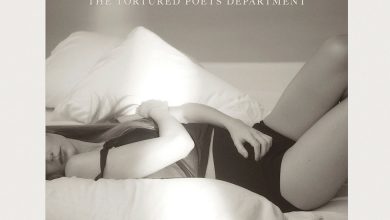‘Stereophonic’ Finds Drama in a ’70s Rock Recording Booth

A decade ago, the playwright David Adjmi was listening to music on a flight to Boston when Led Zeppelin’s “Babe I’m Gonna Leave You” came on. The tune was familiar — he used to overhear his brother play it in his room — but he really listened to it that day, and became mesmerized by Robert Plant’s scorching vocals.
“I was like, ‘God, this must have been so crazy in the studio because it’s so electric and so Dionysian and all over the map, emotionally, and raw,’” Adjmi said. “I saw the studio, I saw the whole thing in my head. Then I started thinking about the theatrical opportunities for setting a play in a studio, and how to play with sound.”
That seed of an idea turned into “Stereophonic,” which is now in previews at Playwrights Horizons and is his first New York production since “Marie Antoinette” in 2013.
As Adjmi (“Elective Affinities,” “3C”) envisioned on that plane, the action unfolds in a recording studio, where a rock band’s protracted work on an album straddles a year from 1976-77. “It really is like the process and the play are blurring because these people are in a studio forever,” Adjmi, 50, said. “And we’ve been doing this — we almost talk about it like it’s a cult, because we just kept doing this over and over for years.” (In a 2020 interview, he mentioned talks for a Broadway run; they did not pan out.)
Adjmi was taking a lunch break between rehearsals at the theater, sitting with the director Daniel Aukin (“Fool for Love”) and the former Arcade Fire member Will Butler, who wrote several songs for the play’s fictional quintet.The idea was enough for them to sign on, and Butler, who now leads Will Butler + Sister Squares, had to wait years for the script to be completed before he could begin the songs. “The music is all reverse-engineered,” he said. “It was like, ‘Here’s a space that people are arguing about — how do you fill it so that the details of what they’re arguing about is accurate?’ It’s a very puzzle-piece way to compose the music.”
Since the band is meant to be entering stardom (its previous album is hitting a belated stride in the play), its material has to sound as if it could top the Billboard charts, which put extra pressure on Butler, 41. “What a stupid idea to have them play the song,” he said, as his collaborators cracked up. “You’re not supposed to have them play the song, you idiot!”
At this point it should be emphasized that “Stereophonic” is a play with music rather than a musical, making it somewhat of an oddity in an American theatrical landscape that has not much milked the rock scene’s dramatic potential. Adjmi said he thinks that’s “because we are the originator of the Broadway musical and there’s a very kind of calcified idea of what musicals are and how music should feel in the theater.” He added, “And I have an allergy to a lot of it. Not all of it, but a lot of it, because I can’t relate.”
The musicals he did praise are backstage classics — “A Chorus Line,” “Dreamgirls,” “42nd Street” — and, perhaps not coincidentally, “Stereophonic” is a behind-the-scenes look at the process of creation. Its unnamed band includes two couples. The steady, no-nonsense keyboard player and singer, Holly (Juliana Canfield, who played Kendall Roy’s assistant Jess on “Succession”), and the substance-abusing bassist, Reg (Will Brill), both British expats, are separated at the start of the show. The singer Diana (Sarah Pidgeon) and the guitarist-producer, Peter (Tom Pecinka), both Americans, are partners and rivals in love and songwriting. As for the British drummer, Simon (Chris Stack), he makes the most of his wife’s absence.
All of this and a mid-70s California setting might evoke the rather popular band famous for “Rhiannon” and “Go Your Own Way,” but “Stereophonic” is not a play à clef about Fleetwood Mac. “There’s something about the mythos behind various bands that is in the culture,” Aukin said. “It’s almost using snippets from various bands’ histories and the histories of making some of these famous albums and using it as a sort of distant echo. We talked about many bands but we never talked about one.”
In a phone interview, Canfield, 31, recalled that when she asked Adjmi for reference material, he recommended Keith Richards’s memoir, “Life,” and “Original Cast Album: Company,” the D.A. Pennebaker documentary about the fraught, stressful recording that preserved Stephen Sondheim and George Furth’s 1970 musical for posterity.
That film closely tracked the “Company” actors as they painstakingly performed take after take or made tiny pronunciation changes, while members of the producing team and Sondheim himself watched, gave notes and rolled their eyes. “Stereophonic” also plunges us into the middle of the action as David Zinn’s set features the mixing table in the foreground and the recording booth in the back. A pair of engineers (Eli Gelb and Andrew R. Butler, no relation to Will) take in both the personal clashes and the mix of inspiration and drudgery involved in art-making — all of which, of course, constantly feed off one another.
In real life, arguments about adjusting levels or when to use a click track might make even a Steely Dan fan’s eyes glaze over. But the show does not sweep the grind of creation under the rug, especially as Peter evolves into an obsessive taskmaster. “God is in the details, but the details are boring in themselves,” Adjmi said. “So I took that as a challenge, like, ‘OK, let me see if I can turn this into something dramatically exciting.’ So much of it, the banality of the process, is part of what’s so beautiful about it, the granularity of it.”
For the technical elements, Adjmi and Aukin consulted experts like their show’s sound designer, Ryan Rumery, and the longtime Steve Reich collaborator John Kilgore. Butler himself proved to be a ready source about interpersonal relationships among musicians. “My last band was with my brother and his wife and my new band is with my wife and her sister,” he said. “I’ve only ever been in bands with married people so I was like, ‘Oh, this makes sense. This feels real.’”
That naturalism is different stylistic territory for Adjmi, whose previous plays tended to be arch in a manner he described as “expressionist.” The new show has more of a fly-on-the-wall quality. “That was an experiment for me: Can I reveal myself vis-à-vis these characters by creating real dimension and real nuance, and give actors really juicy roles,” Adjmi said. “ I wanted to do something that would be more fun for them.”
Perhaps, but his writing remains dense, with challenging, precisely timed overlaps in the dialogue. “I don’t think it’s an accident that the play is about music and about the cooperation of a group of people making it together, because the play itself, excluding the music, feels very scored,” Canfield said.
As if that weren’t enough, the cast members who are in the band also have to play their own instruments and sing as well as convey the excesses that the 1970s were famous for. “I have a couple of scenes where I go from being really emotionally devastated and quite inebriated to walking into the music room and playing something very precise on the bass,” said Brill, whose credits include Daniel Fish’s “Oklahoma!” and Jack Serio’s “Uncle Vanya” in a loft. “To keep the emotional and interpersonal dynamics running, and keep the verisimilitude of a drunk person, while executing something technically perfectly is a real challenge. It’s a delightful challenge, too,” he continued.
For the production to work, the actors must feel like a believably tight unit. “We’re trying to make a band here — it’s not like, ‘Open your score to Page 6,’” Butler said. “We’re trying to figure out people’s strengths and weaknesses, because that’s what a band is. When they start playing music together, there is some connection.”
Fortunately, the actors said, they all clicked. “When all of us get in the room together, the sounds of the voices blend incredibly well and there’s a real sense of camaraderie amongst us,” said Brill, 37, who played guitar in another fictional band a decade ago, in the David Chase film “Not Fade Away.” Canfield recalls that one day the show’s music director, Justin Craig, overheard her, Pecinka and Pidgeon bickering about their harmonies, and joked that they were now a real band because they were arguing about the music.
As realistic as that episode must have felt, it pales when compared to the toughest credibility test the would-be rockers have had so far. Last month, Butler asked the “Stereophonic” band to open for him at his record-release gig in Brooklyn. Canfield, dreading what she called “an ego death” fiasco, balked, and Brill had to joke-taunt her into it.
“He said ‘Yeah, Juliana, it’s going to be such a good story in 20 years, when we tell people that we almost opened for Will Butler’s band but we didn’t because we were scared that we would be bad,’” she said. “And I was like, OK, screw you, I guess we’re doing it.” Now that’s rock ’n’ roll.



